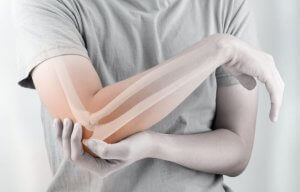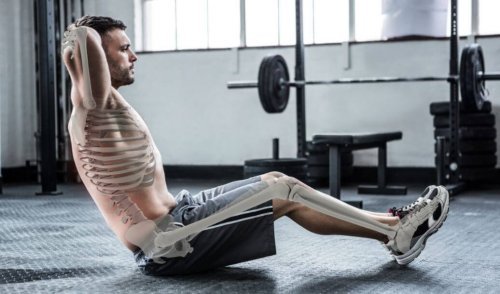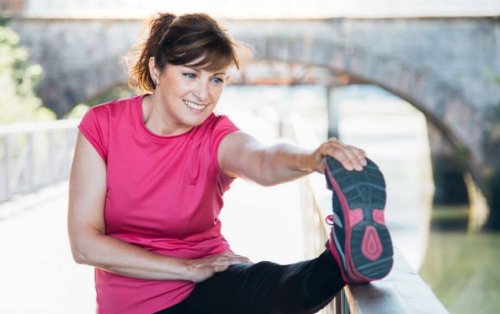How to Improve our Joints and Bones

We often talk about muscles in sports, but an important part of our health when training is related to our joints and bones. From the age of 30, we can experience pain inside and outside of training. The lack of attention can generate serious injuries.
Maintaining bone mass in adulthood
Bone growth occurs as a progressive process that takes place during childhood, adolescence, and early adulthood. Once we’re over the age of 30, our bones become larger and reach their maximum growth.
From this decade and on, our bone structure begins its wear and tear. This is when athletes must take measures so that the degradation isn’t too severe.
In the case of women, the decalcification process is usually much stronger. Bone loss accelerates due to factors such as menopause. That’s why women tend to use food supplements earlier in life. In this scenario, their greatest risk is osteoporosis.
How to protect the bones
The mere act of exercising and complying with a meal plan is in itself the first measure of protection. At this point, our diets can’t solely be based on the desire to lose weight or gain muscle mass.
It is fundamental to focus on the intake of essential food elements. The first is access to calcium, perhaps the most influential mineral in the bone structure. Calcium carbonate and phosphate compose 45 percent of our bones.

Another vital component in bone maintenance is vitamin D. The problem is that this substance isn’t easy to obtain. Its main source is exposure to sunlight, so it’s always good to take some sun early in the morning. Now, we can understand why a sedentary lifestyle contributes to the degradation of our bone structure.
The importance of joints
The passing of time can also be reflected in our joints and bones. With respect to the former, the greatest risk is osteoarthritis or joint swelling. Its origin lies in the early loss of cartilage and the weakening of its associated muscles.
These discomforts almost always occur in localized areas: legs, knees, or parts of the arms. In the case of athletes, the main issue is that this condition can generate a certain rigidity. Sports performance is considerably affected by osteoarthritis.
However, these types of ailments can be prevented. Exercise can be the key to avoiding these pains, but it can also be the cause. In this sense, warmth and correct physical activity will be the keys to success.
Joint and bone protection
In regards to joints, exercise is also a protection mechanism provided it’s performed correctly. Adequate warm-ups are necessary to avoid injuries. Likewise, carrying out our exercises using the appropriate postures and procedures becomes indispensable.

Joint injuries can be much more severe and recurrent during advanced adulthood. This means that people over 40 should be very aware of their physical limits.
Moreover, it’s necessary to maintain control over several body conditions: proper weight and avoiding overloads are priority requirements.
Special care is also crucial. This includes the application of heat, massages, and other physiotherapeutic elements. The states of depression and stress must also be eradicated.
Training for adulthood: applying common sense
When we’re young, it’s normal to exceed our limits. In fact, our bodies have the necessary characteristics at that stage of our lives, to encourage us to overreach. With the arrival of old age, we are responsible for managing our energy and bodily resources.
Rest occupies a determining factor in the recovery and administration of our physique. Each training session must be performed with intelligence and vigilance. At this stage, the protection of our joints and bones is also a matter of intelligence.
We often talk about muscles in sports, but an important part of our health when training is related to our joints and bones. From the age of 30, we can experience pain inside and outside of training. The lack of attention can generate serious injuries.
Maintaining bone mass in adulthood
Bone growth occurs as a progressive process that takes place during childhood, adolescence, and early adulthood. Once we’re over the age of 30, our bones become larger and reach their maximum growth.
From this decade and on, our bone structure begins its wear and tear. This is when athletes must take measures so that the degradation isn’t too severe.
In the case of women, the decalcification process is usually much stronger. Bone loss accelerates due to factors such as menopause. That’s why women tend to use food supplements earlier in life. In this scenario, their greatest risk is osteoporosis.
How to protect the bones
The mere act of exercising and complying with a meal plan is in itself the first measure of protection. At this point, our diets can’t solely be based on the desire to lose weight or gain muscle mass.
It is fundamental to focus on the intake of essential food elements. The first is access to calcium, perhaps the most influential mineral in the bone structure. Calcium carbonate and phosphate compose 45 percent of our bones.

Another vital component in bone maintenance is vitamin D. The problem is that this substance isn’t easy to obtain. Its main source is exposure to sunlight, so it’s always good to take some sun early in the morning. Now, we can understand why a sedentary lifestyle contributes to the degradation of our bone structure.
The importance of joints
The passing of time can also be reflected in our joints and bones. With respect to the former, the greatest risk is osteoarthritis or joint swelling. Its origin lies in the early loss of cartilage and the weakening of its associated muscles.
These discomforts almost always occur in localized areas: legs, knees, or parts of the arms. In the case of athletes, the main issue is that this condition can generate a certain rigidity. Sports performance is considerably affected by osteoarthritis.
However, these types of ailments can be prevented. Exercise can be the key to avoiding these pains, but it can also be the cause. In this sense, warmth and correct physical activity will be the keys to success.
Joint and bone protection
In regards to joints, exercise is also a protection mechanism provided it’s performed correctly. Adequate warm-ups are necessary to avoid injuries. Likewise, carrying out our exercises using the appropriate postures and procedures becomes indispensable.

Joint injuries can be much more severe and recurrent during advanced adulthood. This means that people over 40 should be very aware of their physical limits.
Moreover, it’s necessary to maintain control over several body conditions: proper weight and avoiding overloads are priority requirements.
Special care is also crucial. This includes the application of heat, massages, and other physiotherapeutic elements. The states of depression and stress must also be eradicated.
Training for adulthood: applying common sense
When we’re young, it’s normal to exceed our limits. In fact, our bodies have the necessary characteristics at that stage of our lives, to encourage us to overreach. With the arrival of old age, we are responsible for managing our energy and bodily resources.
Rest occupies a determining factor in the recovery and administration of our physique. Each training session must be performed with intelligence and vigilance. At this stage, the protection of our joints and bones is also a matter of intelligence.
All cited sources were thoroughly reviewed by our team to ensure their quality, reliability, currency, and validity. The bibliography of this article was considered reliable and of academic or scientific accuracy.
Zazula, F. C., & dos Santos Pereira, M. A. (2003). Fisiopatologia da osteoporose e o exercício físico como medida preventiva. Arquivos de Ciências da Saúde da UNIPAR, 7(3).
de Souza Duarte, V., dos Santos, M. L., de Abreu Rodrigues, K., Ramires, J. B., Arêas, G. P. T., & Borges, G. F. (2017). Exercícios físicos e osteoartrose: uma revisão sistemática. Fisioterapia em Movimento, 26(1).
This text is provided for informational purposes only and does not replace consultation with a professional. If in doubt, consult your specialist.








